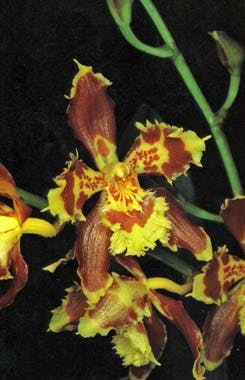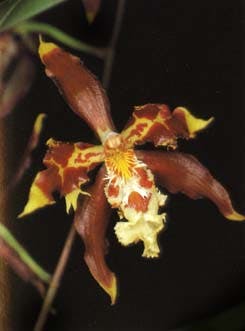Text and photos by Stig Dalstrom

This smaller plant of Onc. luteopurpureum, which is found near Medellin, Colombia, is known in cultivation as "Oncidium sceptrum."
Oncidium luteopurpureum was described by Professor Lindley on page 16 in his Orchidaceae Lindenianae (1846). It was a plant discovered by Linden a couple of years earlier in the forests of Quindio at an elevation of 8,860 feet (2,700 m) in the Central Cordillera in Colombia. Since Lindley only saw a dried specimen, he interpreted the colors of the flowers as being yellow and purple, hence the name. However, in a living state the flowers of this variable species are almost exclusively yellowish with brownish spots and markings. Approximately 20 years later, this species became better known through the introduction of living plants by various collectors. Plants were collected both in the Central and the Eastern Cordillera where this species still is fairly common. As in many other cases, the growers discovered a number of "different" plants that had been gathered together with Onc. luteopurpureum and that subsequently were described as separate species. But as the taxonomical knowledge increased with the flow of freshly collected plants, growers and taxonomists realized that many of these "species" merely represented the natural variation of a widely distributed and variable taxon. There were also several suspected natural hybrids discovered this way.

Oncidium luteopurpureum from Fusagasuga in the Eastern Cordillera.
These discussions can be studied in several contemporary publications, such as Reichenbach's Xenia Orchidacea (1868, 1874), The Gardeners Chronicle (1882) and Veitch's A Manual of Orchidaceous Plants (1887-94). It is clearly stated that reasonable "borders" between the many forms of this species are impossible to maintain, and that they should be regarded as subspecies varieties or "garden forms" only. Some are more distinct than others.
This information is important and useful today, considering the enormous number of plants that must have been available in the nurseries at the time. If the growers and botanists then could see how these plants graded into each other, there is no reason to doubt their words today.
Despite that Reichenbach and others who worked with these plants apparently agreed on lumping them into Onc. luteopurpureum, this decision is not entirely supported today. Bockemühl (1989) insists that one of these forms, Oncidium sceptrum Rchb.f. and Warsz., is a distinct species, not even closely related to the "superspecies" Onc. luteopurpureum.
Bockemühl claims that this "species' lacks close relatives due to the "short" column. All other characteristics pointing toward Onc. luteopurpureum are ignored.
But let us go back to the type description of Onc. sceptrum in Bonplandia (1854). Here, Reichenbach declares that the flowers are slightly larger than Onc. luteopurpureum. Furthermore, there is no designated collector or collection number in the description, only the country of origin (Colombia = New Grenada). Bockemühl believes that the type specimen (which Reichenbach used for his description), is in the Herbarium at the Royal Botanic Gardens, Kew, labeled "O. sceptrum' R. 37. Warsz. The problem is that these flowers do not show any particular differences from the flowers of the type of Onc. luteopurpureum.
However, not until 1868 did the form that we today call "Oncidium sceptrum" become known through live plants. Wallis, who frequently collected near Medellin, managed to send plants to Linden's orchid establishment in Belgium. This information is submitted by Veitch, who writes in his Manual of Orchidaceous Plants, 2, p. 46: "Oncidium luteopurpureum var. sceptrum, Flowers smaller with broader segments and a more regular contour."
In other words, we do not know for sure which specimen Reichenbach used as a type for Onc. sceptrum. If it is the Warszewicz specimen labeled "R.37.," the collection site remains a mystery. Finally it does not look like the smaller-and-rounder form, known today as that "species" but rather as a "normal" form of Onc. luteopurpureum.
In 1989, I had the privilege to see some plants of the so-called "Oncidium sceptrum" in the wild. It is still fairly common in the vicinity of Medellin, where it grows in wetter areas as an epiphyte or terrestrially along the road cuts.
Despite that very little forest remains in the area, I was fortunate to find enough plants in bloom to get an idea of its natural variation. In some cases, the plants were smaller, with small round flowers and sometimes they were bigger, carrying larger and more stellate (starlike) flowers that looked like the supposed type of Onc. sceptrumas well as Onc. luteopurpureum. It was also interesting to see how the shape and size of the flowers change in cultivation, depending on the health of the plant. My conclusion is that this is nothing but a geographical form of Onc. luteopurpureum or at most a subspecies.
Dealing with oncidiums, it is risky using a single morphological feature such as the length of the column, as taxonomically significant. These notoriously changeable plants are not to be trusted. For instance, the length of the column can vary in many species despite that other features are the same. In Oncidium kegeljani E. Morren (the Onc. epidendroides complex), there are two groups of plants that differ only in the length of the column. Whether this difference indicates the existence of separate forms or subspecies, or merely the fact that I have measured large and small flowers of the same taxon, remains to be investigated. It is like classifying people shorter than 6 feet as one species and those who are taller as another species (intermediate forms are ''natural hybrids"). We could do it, but it would hardly reflect a natural classification in my mind.

Oncidium luteopurpureum as published in Lindenia; Vol. I, plate LVIII
Reichenbach, together with Linden, also described Oncidium schlimii, in the same year and in the same publication as Onc. sceptrum (1854). The plants had been collected by Schlim (nr. 405) near Ocana in the Eastern Cordillera during his trip in 1846-52. Reichenbach later considered this "species" as a "variety" of Oncidium luteopurpureum.A second specimen of Onc. schlimii can be found in the Herbarium at Kew (Schlim 1024). It is mounted on the same sheet as a specimen labeled "Oncidium schlimii, Warszewicz, New Grenada."
Bockemühl treats Onc. schlimii as a synonym of "Oncidium sceptrum," probably due to the smaller flowers which are similar in size. But again, when we study the type specimen a little bit closer we get another picture.
But there is another dubious species that needs to be mentioned first. Oncidium tripudians Rchb.f. and Warsz. was also described in Bonplandia (1854). It was based on a plant collected by Warszewicz during his journey to South America around 1850. He also sent live plants to Linden's nursery, where they flowered a few years later. Somehow the type of Onc. tripudians, which is in the Reichenbach herbarium in Vienna, was believed to have come from Peru. Since nothing similar has been reported from Peru, only from northeastern Colombia, I assume that the labels were "mixed" somewhere along the way (especially since we know that Warszewicz was in Colombia when he collected the "schlimii" specimen and the supposed type ofOnc. sceptrum var. sceptrum, at Kew).
Morphologically, the type of Onc. tripudians is practically identical to Onc. schlimii. Hence, I consider them to be the same species. This conclusion is supported by the herbarium sheet at Kew, which indicates that Warszewicz was in the area where this species occurs.
So how did this mess get started? Permitting myself some speculation, it appears that Warszewicz and Schlim collected the same species, probably in the same area at about the same time. Since it is a common practice among collectors to spread botanical discoveries to several herbaria, Warszewicz and Schlim sent their inflorescences both to Kew and to Reichenbach (and possibly to other herbaria as well). Reichenbach described the Schlim specimen from Ocafia as Onc. schlimii, and the Warszewicz specimen, which lacked information about its origin but was believed to have come from Peru, as Onc. tripudians. At Kew they were both determined as Onc. schlimii and ended up on the same sheet.
Why Peru then? Well, Warszewicz actually visited Ecuador and Peru during his journey, where many of his Oncidium discoveries were made. Possibly it was assumed that Oncidium tripudians was collected there as well.
This latter name has been used for this species until today and should therefore be used, while Oncidium schlimii becomes the synonym.
Oncidium tripudians has since only been collected sparsely in the northeastern part of Colombia at elevations around 6,560 to 9,840 feet (2,000 to 3,000 m). It apparently occurs on both sides of the Eastern Cordillera. Morphologically it has a very peculiar shape and appears like something in between the Onc. epidendroides, Onc. cristatum and the Onc. cruentum complexes, with characteristics such as the rectangular but fringed column wings and the large and radiating colored keels on the lip.
Bockemühl compares it with Oncidium spectatissimum Lindl. (the Onc. epidendroides complex), while I would rather place it in the cristatum complex, to which Oncidium luteopurpureum also must be affiliated. However, since I have very little personal experience with Oncidium plants from this part of Colombia, I admit that I am speculating here. The fact that Onc. tripudians always has been regarded as "rare and variable" (a suspicious combination) leaves space for surprises.
Maybe it simply is the northernmost form of the Onc. cristatumcomplex, which otherwise seems to be absent there, or perhaps an independent natural link that ties the different species complexes together.
None of the forms of Onc. luteopurpureum have been reported from Venezuela nor Ecuador, although there are rumors that it may occur in the northern districts of Ecuador, close to the Colombian border. But since the forests disappear so fast we may never find out for sure.
References
Bockemühl, L. 1989. Odontoglossum: A Monograph and Iconograph. Briicke-Verlag Kurt Schmersow, D-3200 Hildesheim.
Dalstrom, S. 1995. Enigmatic Odontoglossums, part 1: the epidendroides complex, Amer. Orchid Soc. Bull. 64(111:1218-1223.
_.1996. Enigmatic Odontoglossums, part 2: the cruentum complex, part one. Orchids 65( 11:20-25. _. Enigmatic Odontoglossums, part 3: the cruentum complex, part two: Orchids 65(31:270-273. Lindley, J. 1846.
Orchidaceae Lindenianae, p. 16 (description of Odontoglossum luteopurpureum).
Reichenbach, H. G. 1854. Bonplandia. 2, pp. 99, 100, 278.
_. 1868. Xenia Orchidacea, 2. p. 151.
_.1874. Xenia Orchidacea. 2. p. 194.
Veitch, J. 1887-94. A Manual of Orchidaceous Plants, 2, pp. 1-80.
republished from Orchids magazine, vol. 65, #11; November 1996








